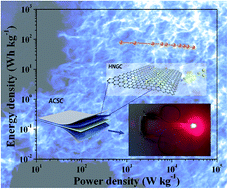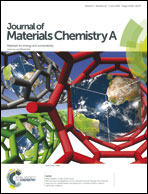Achieving battery-level energy density by constructing aqueous carbonaceous supercapacitors with hierarchical porous N-rich carbon materials†‡
Abstract
Pseudocapacitive materials hold great promise for achieving battery-level energy density integrated with power-related preponderance of electrostatic capacitors. However, it still remains a great challenge to find suitable capacitive material pairs to provide high operating voltage and high-level capacitance with good rate capability. Here, a three-dimensional hierarchical porous N-rich graphitic carbon (HNGC) material was prepared to construct novel symmetric aqueous carbonaceous supercapacitors (ACSCs). With ultrathin slice units, highly graphitic texture, and copious heteroatom functionalities, HNGC significantly promoted the faradic pseudo-capacitance, demonstrating an extremely high single-electrode capacitance of over 710 F g−1 in 1 M H2SO4 aqueous solution. First-principles computations revealed that copious N-induced defects tremendously boost the electrochemical performance of HNGC in acidic electrolytes by accommodating more protons, facilitating ion mobility and interfacial charge transport. Due to the co-existence of both electrical double-layer capacitance and pseudo-capacitance, the novel symmetric ACSCs with both structural and elemental advantages provide high operating voltage and a further high-level energy density of over 75 W h kg−1electrodes at a large power density of 1500 W kg−1, achieving battery-level energy density while retaining capacitor-level power delivery ability (30 kW kg−1) and cycling stability (ultra-long 8000 cycles). The proof-of-concept design of ACSCs outclasses the generally known high-voltage asymmetric counterparts under the same power and represents an advance towards battery-level energy density in supercapacitors.



 Please wait while we load your content...
Please wait while we load your content...